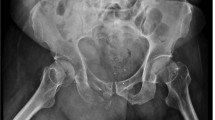Abstract
Tumor lysis syndrome is a well-described, serious complication of chemotherapy administered to treat malignancies. However, a very rare event resulting in the spontaneous necrosis of a tumor prior to therapy can also occur, which is termed spontaneous tumor lysis syndrome (STLS). We present a case of a 27-year-old male who presented to the hospital with epistaxis, dyspnea, and cervical lymphadenopathy. Laboratory findings included progressive pancytopenia, hyperuricemia, and acute renal failure. Bone marrow biopsy showed a T cell lymphoid neoplasm that had entirely infiltrated the marrow stroma. The patient was diagnosed with STLS in the setting of a T cell lymphoma with bone marrow infiltration. The patient was immediately treated with a blood transfusion and hemodialysis. After this urgent treatment, the patient’s pancytopenia resolved and the lymphadenopathy disappeared spontaneously. One month post-treatment, the patient’s cervical lymphadenopathy recurred and peripheral T cell lymphoma, not otherwise specified, was confirmed. STLS has previously been reported, however, most known cases of STLS did not show a decreased tumor burden resulting from massive tumor cell death. We present a rare case of STLS with resolution of pancytopenia and disappearance of lymphadenopathy in a patient with peripheral T cell lymphoma not otherwise specified.





Similar content being viewed by others
References
Yarpuzlu AA. A review of clinical and laboratory findings and treatment of tumor lysis syndrome. Clin Chim Acta. 2003;333:13–8.
Coiffier B, Altman A, Pui CH, Younes A, Cairo MS. Guidelines for the management of pediatric and adult tumor lysis syndrome: an evidence-based review. J Clin Oncol. 2008;26:2767–78.
Van den Berghe G. Purine and pyrimidine metabolism between millennia: what has been accomplished, what has to be done? Adv Exp Med Biol. 2000;486:1–4.
Wechsler DS, Kastan MB, Fivush BA. Resolution of nephrocalcinosis associated with tumor lysis syndrome. Pediatr Hematol Oncol. 1994;11:115–8.
Davidson MB, Thakkar S, Hix JK, Bhandarkar ND, Wong A, Schreiber MJ. Pathophysiology, clinical consequences, and treatment of tumor lysis syndrome. Am J Med. 2004;116:546–54.
Locatelli F, Rossi F. Incidence and pathogenesis of tumor lysis syndrome. Contrib Nephrol. 2005;147:61–8.
Hande KR, Garrow GC. Acute tumor lysis syndrome in patients with high-grade non-Hodgkin’s lymphoma. Am J Med. 1993;94:133–9.
Cairo MS, Bishop M. Tumour lysis syndrome: new therapeutic strategies and classification. Br J Haematol. 2004;127:3–11.
Jasek AM, Day HJ. Acute spontaneous tumor lysis syndrome. Am J Hematol. 1994;47:129–31.
Hsu HH, Huang CC. Acute spontaneous tumor lysis in anaplastic large T-cell lymphoma presenting with hyperuricemic acute renal failure. Int J Hematol. 2004;79:48–51.
Feld J, Mehta H, Burkes RL. Acute spontaneous tumor lysis syndrome in adenocarcinoma of the lung. Am J Clin Oncol. 2000;23:491–3.
Vaisban E, Braester A, Mosenzon O, Kolin M, Horn Y. Spontaneous tumor lysis syndrome in solid tumors: really a rare condition? Am J Med Sci. 2003;325:38–40.
Chen RL, Chuang SS. Transient spontaneous remission after tumor lysis syndrome triggered by a severe pulmonary infection in an adolescent boy with acute lymphoblastic leukemia. J Pediatr Hematol Oncol. 2009;31:76–9.
Acknowledgments
This case was supported by research fund from Chosun University, 2010.
Author information
Authors and Affiliations
Corresponding author
About this article
Cite this article
Park, SG., Chung, CH. & Park, CY. Spontaneous tumor lysis syndrome with resolution of pancytopenia and disappearance of lymphadenopathy in a patient with peripheral T cell lymphoma unspecified. Int J Hematol 93, 394–399 (2011). https://doi.org/10.1007/s12185-011-0788-9
Received:
Revised:
Accepted:
Published:
Issue Date:
DOI: https://doi.org/10.1007/s12185-011-0788-9




